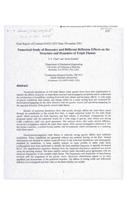
Numerical Study of Buoyancy and Different Diffusion Effects on the Structure and Dynamics of Triple Flames
Series:
Numerical simulations of 2-D triple flames under gravity force have been implemented to identify the effects of gravity on triple flame structure and propagation properties and to understand the mechanisms of instabilities resulting from both heat release and buoyancy effects. A wide range of gravity conditions, heat release, and mixing widths for a scalar mixing layer are computed for downward-pr
NaN
VOLUME
English
Paperback

Numerical simulations of 2-D triple flames under gravity force have been implemented to identify the effects of gravity on triple flame structure and propagation properties and to understand the mechanisms of instabilities resulting from both heat release and buoyancy effects. A wide range of gravity conditions, heat release, and mixing widths for a scalar mixing layer are computed for downward-propagating (in the same direction with the gravity vector) and upward-propagating (in the opposite direction of the gravity vector) triple flames. Results of numerical simulations show that gravity strongly affects the triple flame speed through its contribution to the overall flow field. A simple analytical model for the triple flame speed, which accounts for both buoyancy and heat release, is developed. Comparisons of the proposed model with the numerical results for a wide range of gravity, heat release and mixing width conditions, yield very good agreement. The analysis shows that under neutral diffusion, downward propagation reduces the triple flame speed, while upward propagation enhances it. For the former condition, a critical Froude number may be evaluated, which corresponds to a vanishing triple flame speed. Downward-propagating triple flames at relatively strong gravity effects have exhibited instabilities. These instabilities are generated without any artificial forcing of the flow. Instead disturbances are initiated by minute round-off errors in the numerical simulations, and subsequently amplified by instabilities. A linear stability analysis on mean profiles of stable triple flame configurations have been performed to identify the most amplified frequency in spatially developed flows. The eigenfunction equations obtained from the linearized disturbance equations are solved using the shooting method. The linear stability analysis yields reasonably good agreements with the observed frequencies of the unstable triple flames. The frequencies and amplitudes of dist...
Price Comparison [India]
In This Series
Bestseller Manga
Trending NEWS




















